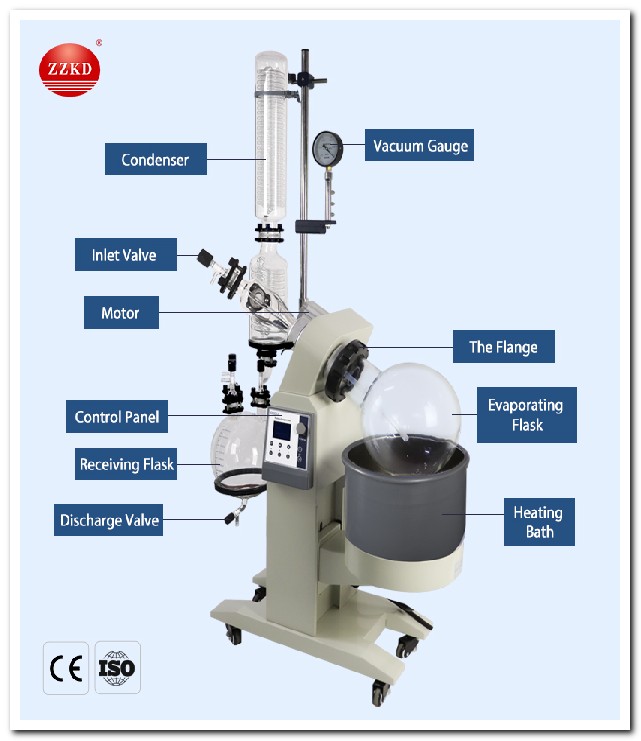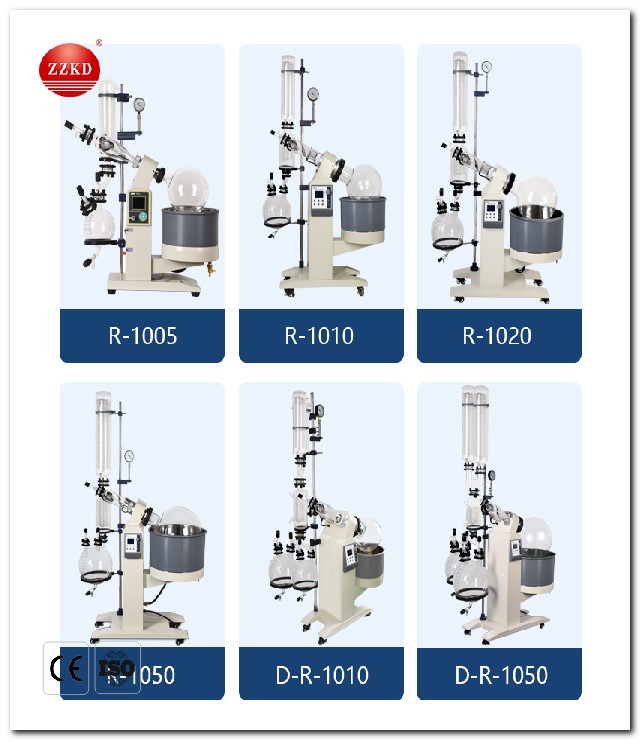Correct Maintenance Steps For Rotary Evaporator
The working principle of the rotary evaporator is as follows:
Through the control of certain conditions, the evaporation flask is rotated at a set speed at a constant speed to increase the evaporation area. The evaporating flask is in a negative pressure state by a circulating water vacuum pump. The evaporating flask is heated at a constant temperature in a water bath while rotating, and the solution in the evaporating flask is heated, diffused and evaporated in the rotating flask under negative pressure. The rotary evaporator system can be sealed and decompressed to 400-600 mm Hg; the solvent in the distillation flask is heated, and the heating temperature can be close to the boiling point of the solvent; at the same time, it can be rotated at a speed of 50-160 rpm to make the solvent form thin film to increase the evaporation area. In addition, under the action of the condenser tube, the hot steam can be quickly liquefied and the evaporation rate can be accelerated.The rotary evaporator is mainly composed of these components:
1. Rotate the motor to drive the evaporating bottle through rotation.2. Evaporation pipeline, the support shaft for the rotation of the evaporation bottle, and the vacuum-sealed pipeline for extracting the steam from the material.
3. The vacuum system reduces the pressure in the evaporator system and reduces the boiling point of the material.
4. Heating bath, usually use water or oil to heat the material.
5. Condenser, in order to speed up the condensation efficiency, it is usually made into a double snake surround type, and then a condensing agent such as dry ice and acetone is added to condense the sample.
6. The condensed water collection bottle at the bottom of the condenser is used to capture the distillation solvent after recondensation and collect the sample.
7. Lifting device, a mechanical or motorized mechanism that quickly lifts the evaporating flask from the heating bath.

Generally, Rotary Evaporator replacement parts will be the above parts.
How to use the rotary evaporator:
1. Turn on the low temperature coolant circulation pump. Pay attention to press the power button and then press the cooling button, and start the cycle after the temperature is reduced to the desired temperature.2. Turn on the water pump to circulate the water.
3. Install the distillation flask and secure with clips. Turn on the vacuum pump and start to rotate after a certain vacuum.
4. Adjust the height and rotation speed of the distillation flask, and set an appropriate water bath temperature.
5. After steaming, stop the rotation first, then open the atmosphere, then stop the water pump, and finally remove the distillation flask.
6. Stop the low-temperature coolant circulation pump, stop the heating of the water bath, turn off the water pump to circulate the water, pour out the solvent in the receiving bottle, wash the buffer ball and receive the bottle.
Rotary evaporators can be used to recover and evaporate organic solvents. It uses a motor to drive the retort to rotate. Since the still is constantly rotating, zeolite can be dispensed with without bumping. At the same time, due to the continuous rotation, the liquid is attached to the wall of the distiller, forming a liquid film, which increases the evaporation area and accelerates the evaporation rate.
Maintaining the Rotary Evaporator please do this:
1. Carefully check the instrument before use, whether the glass bottle is damaged, whether the interfaces are consistent, and pay attention to handle it with care.2. Wipe each interface with a soft cloth (can be replaced with a napkin), and then apply a little vacuum grease. Be sure to cover the vacuum grease after use to prevent lime and sand from entering.
3. Each interface should not be over-tightened, and it should be loosened regularly to avoid long-term locking that will cause the connector to die.
4. Turn on the power switch first, and then let the machine run from slow to fast. When the machine is stopped, keep the machine in a stopped state, and then turn off the switch.
5. The PTFE switches everywhere should not be over-tightened, which will easily damage the glass.
6. After each use, all kinds of oil stains, stains and solvent residues left on the surface of the machine must be wiped off with a soft cloth to keep it clean.
7. Unscrew each PTFE switch after stopping, and the PTFE piston will be deformed if it is still in the working state for a long time.
8. Regularly clean the sealing ring, the method is: remove the sealing ring, check whether there is dirt on the shaft, wipe it with a soft cloth, then apply a little vacuum grease, and reinstall it to keep the shaft and the sealing ring smooth.
9. The electrical part must not enter the water, and it is strictly forbidden to get wet.
10. Rotary Evaporator replacement parts must purchase genuine parts from the original factory. The random use of other parts will cause fatal damage to the machine.
11. When doing any repairs or inspections to the machine, be sure to cut off the power and water first. Note that this equipment is a fragile product, please use

Rotary evaporator is an evaporation instrument widely used in laboratories. It consists of a motor, a distillation bottle, a heating pot, a condenser tube and other parts. It is mainly used for continuous distillation of volatile solvents under reduced pressure conditions. It is used in chemistry, chemical industry, biology, etc.
If you need any type of rotary evaporator, capacity: 10L (R-1010 rotary evaporator), 20L (R-1020 rotary evaporator), 50L (R-1050 rotary evaporator), etc., you can contact us at any time! We are happy to provide you with a quote!




